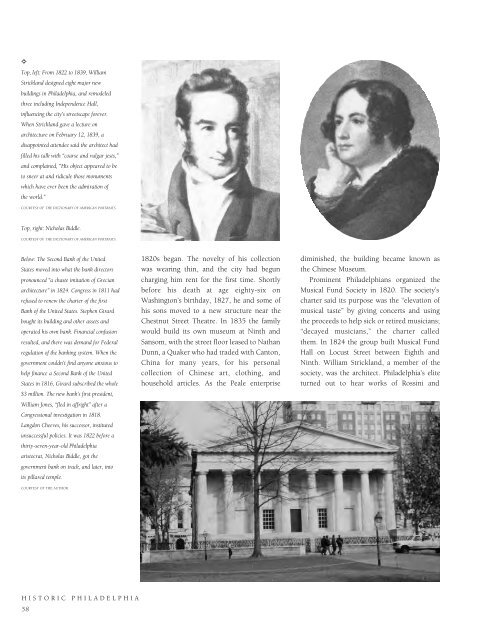Historic Philadelphia
An illustrated history of the city of Philadelphia, paired with the histories of companies, families and organizations that make the region great.
An illustrated history of the city of Philadelphia, paired with the histories of companies, families and organizations that make the region great.
Create successful ePaper yourself
Turn your PDF publications into a flip-book with our unique Google optimized e-Paper software.
✧<br />
Top, left: From 1822 to 1839, William<br />
Strickland designed eight major new<br />
buildings in <strong>Philadelphia</strong>, and remodeled<br />
three including Independence Hall,<br />
influencing the city’s streetscape forever.<br />
When Strickland gave a lecture on<br />
architecture on February 12, 1839, a<br />
disappointed attendee said the architect had<br />
filled his talk with “coarse and vulgar jests,”<br />
and complained, “His object appeared to be<br />
to sneer at and ridicule those monuments<br />
which have ever been the admiration of<br />
the world.”<br />
COURTESY OF THE DICTIONARY OF AMERICAN PORTRAITS.<br />
Top, right: Nicholas Biddle.<br />
COURTESY OF THE DICTIONARY OF AMERICAN PORTRAITS.<br />
Below: The Second Bank of the United<br />
States moved into what the bank directors<br />
pronounced “a chaste imitation of Grecian<br />
architecture” in 1824. Congress in 1811 had<br />
refused to renew the charter of the first<br />
Bank of the United States. Stephen Girard<br />
bought its building and other assets and<br />
operated his own bank. Financial confusion<br />
resulted, and there was demand for Federal<br />
regulation of the banking system. When the<br />
government couldn’t find anyone anxious to<br />
help finance a Second Bank of the United<br />
States in 1816, Girard subscribed the whole<br />
$3 million. The new bank’s first president,<br />
William Jones, “fled in affright” after a<br />
Congressional investigation in 1818.<br />
Langdon Cheeves, his successor, instituted<br />
unsuccessful policies. It was 1822 before a<br />
thirty-seven-year-old <strong>Philadelphia</strong><br />
aristocrat, Nicholas Biddle, got the<br />
government bank on track, and later, into<br />
its pillared temple.<br />
COURTESY OF THE AUTHOR.<br />
1820s began. The novelty of his collection<br />
was wearing thin, and the city had begun<br />
charging him rent for the first time. Shortly<br />
before his death at age eighty-six on<br />
Washington’s birthday, 1827, he and some of<br />
his sons moved to a new structure near the<br />
Chestnut Street Theatre. In 1835 the family<br />
would build its own museum at Ninth and<br />
Sansom, with the street floor leased to Nathan<br />
Dunn, a Quaker who had traded with Canton,<br />
China for many years, for his personal<br />
collection of Chinese art, clothing, and<br />
household articles. As the Peale enterprise<br />
diminished, the building became known as<br />
the Chinese Museum.<br />
Prominent <strong>Philadelphia</strong>ns organized the<br />
Musical Fund Society in 1820. The society’s<br />
charter said its purpose was the “elevation of<br />
musical taste” by giving concerts and using<br />
the proceeds to help sick or retired musicians;<br />
“decayed musicians,” the charter called<br />
them. In 1824 the group built Musical Fund<br />
Hall on Locust Street between Eighth and<br />
Ninth. William Strickland, a member of the<br />
society, was the architect. <strong>Philadelphia</strong>’s elite<br />
turned out to hear works of Rossini and<br />
HISTORIC PHILADELPHIA<br />
58
















